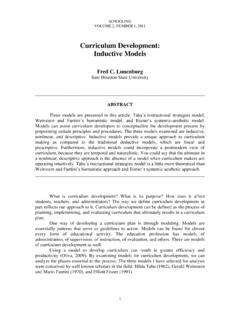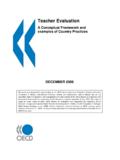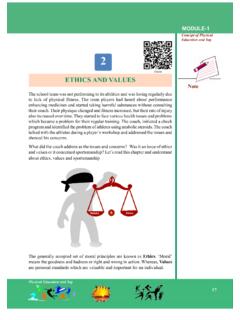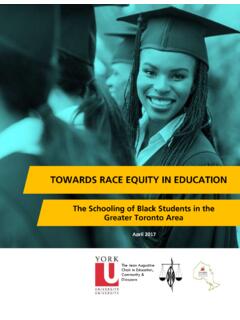Transcription of Full Inclusion: The Benefits and Disadvantages of ...
1 Full Inclusion 1 Full Inclusion: The Benefits and Disadvantages of Inclusive schooling An Overview Kristine McCarty Azusa Pacific University March 11, 2006 Full Inclusion 2 Abstract An overview of debated issues related to the Benefits and Disadvantages of inclusive schooling . The beliefs of districts, school personnel and parents are widely differing as related to the placement of students with special needs in inclusive settings. The examples of current federal laws help to shape the debate of full inclusion in schools today as well as question best practices of pedagogy within all districts. Current legislation that determines the civil rights of a student with disabilities can be clouded by districts due to differing interpretations of the law.
2 Improper use of inclusive terminology regarding special education also furthers the debate and confusion of proper placement for students with special needs. Definition of terms related to special education, mainstreaming, and inclusive schooling help to better understand educational jargon concerning inclusion. Benefits of full inclusion reveal the progress students make socially and academically. Disadvantages of an inclusive setting show the decline of licensed professionals to help students with special needs. Conclusive studies have determined certain Benefits for students with special needs while in a full inclusive setting. While other studies have shown that inclusive schooling is a disadvantage for both the general education and special education student. Success for students with special needs is determined individually by all members of the IEP team to determine if inclusive schooling is a benefit for that individual child.
3 Full Inclusion 3 The Benefits and Disadvantages of Inclusive schooling : An Introduction Inclusion is a widely debated topic among educators and parents alike. Many feel that all children should be educated with their peers regardless of moderate, severe, or even profound disabilities some children may have. Others believe that separate special education classes are the most beneficial for exceptional children needing help beyond the skill level of a general educator. Yet, others agree with the special education programs that districts provide, but feel that children with disabilities should attend general classes when it is determined fit for that particular student. There are many researched factors that lead to the Benefits and Disadvantages of all facets of the inclusion spectrum. These factors can become muddled because of improper use of terminology as related to inclusive schooling . This confusion is widely spread among districts, school personnel and parents making it difficult to discuss and agree on best practices for children with special needs.
4 Many districts and parents have found themselves summoned to arbitrations or cases in where the courts must determine that terminology of the law. Several court cases in the past have helped to determine the proper usage and implementation of inclusive schooling for future public school districts, yet there is no specific language that states how this is to be done. Within the laws that govern the civil rights of each student with special needs there is room for debate as to the language of the law. Each district has now and in the past, deciphered the language of the law depending on their views of inclusive schooling . Federal Law Concerning Individuals with Special Needs Full Inclusion 4 In 1975, Congress passed Public Law 94-142, otherwise known as the Education for All Handicapped Children Act. This law came about a year after the Controller General reported to Congress that 60 percent of the nation s disabled children were not receiving appropriate schooling (Irmsher, 1995, p.)
5 1). Irmsher (1995) goes on to state that millions of children were totally excluded from school all together while others were receiving an education that was not appropriate for their disability. Specifically the law ensures that children with disabilities, including children in public or private institutions and other care facilities, are educated with children who are not disabled (Individuals with Disabilities Education Act, 20 1412 [a][5]) (Kluth, Villa, Thousand, 2002, ). The Education for All Handicapped Children Act was renamed the Individuals with Disabilities Education Act (IDEA) in 1991 (Irnsher, 1995). The re-classification of certain learning disabilities as well as the addition of Autism and Traumatic brain injury was added to the language of the IDEA. The IDEA mandates that children be taught in the least restrictive environment (LRE) as much as possible with their peers that are not disabled (Lipton, 1994).
6 The act also requires that various alternative placement options are required also by the regulations of the Act in order to assure that each student with disabilities receives an education which is appropriate for his/her individual need (Wigle, Wilcox, & Manges, 1994, p. 3). Part of the Individuals with Disabilities Education Act ( 20 1412 [a][5]) states that special classes, separate schooling , or other removal of handicapped children from the regular education environment occur only when the nature or severity of the disability is such that education in regular classes Full Inclusion 5 with the use of supplementary aids and services cannot be achieved satisfactorily . When parents and school districts debate the nature or severity of a students disability it is usually concerning a matter of full inclusion of that student in a general education setting. Most court cases have ruled in favor of individual students with special needs over the school district (Kluth et al.)
7 , 2002). It is inconclusive to say who is right and who is wrong when a matter of least restrictive environment is debated concerning a student within the school system . Pl 94-142 did not define the least restrictive environment (LRE), nor did it use the term mainstreaming (Douvanis & Hulsey, 2002, ). Because Congress has elected not to define the concept of LRE, under our system of government it is left to the courts to shape a definition. There are varying definitions of what constitutes compliance with the least restrictive environment mandate and the concepts of mainstreaming and inclusion. Further complicating the issue is that people frequently use the terms least restrictive environment, inclusion, and mainstreaming interchangeably when they are, in fact, not synonymous concepts (Douvanis & Hulsey, 2002, p. 2). Terms Related To Inclusive schooling Full inclusion refers to including a student with special needs in a general education classroom all day.
8 According to Halvorsen and Neary (2001), inclusion differs from mainstreaming in that students are members of only the general education classroom and do not belong to any other specialized environment based on their disability (Hines, 2001, ). The general education classroom is their room and they Full Inclusion 6 attend their home school. Any related services the student may need are provided in the general education setting. Inclusion implies that students will be taught outside the regular education classroom only when all available methods have been tried and failed to meet their needs (Bateman & Bateman, 2002, p. 2). The concept of mainstreaming is when a student with special needs is in a special education classroom setting for most of the day and is put into a general education class for parts of the day. These times are usually during activities where the student will excel such as math, or reading. The least restrictive environment is any environment that is the least restrictive for that child to succeed as normally as possible in an educational setting.
9 It is determined by the IEP team or group of educators, parents, and other personnel that are involved with the student with special needs. Bateman & Bateman (2002) stated that educating children in the least restrictive environment has been mandated since the 1970 s, when it was a major provision of the Education for All Handicapped Act (PL 94-142) p. 2. The IEP stands for an Individualized Education Plan. This is a federal document that must be agreed to and signed by every party that is at the IEP meeting. The IEP states the goals and objectives for the student and the services that will meet his or her goals whether it be in the general or special education setting. When a child is under age 3 the IEP is called the IFSP or Individualized Family Service Plan. The regular education initiative was started to help the student with special needs be able to participate in the general education setting.
10 In 1985, the Department of Full Inclusion 7 Education s Office of Special Education (OSEP) funded a series of grants for the purpose of investigating instruction plus organizational and administrative issues related to educating students with disabilities in the regular classroom environment. This unified system of delivery has come to be known as the Regular Education Initiative (REI) (Monteith, 1994, ). The expectation was that the student would receive special education services, but would still participate in the general education classroom with the general education teacher assuming responsibility for at least part of the student s education (Bateman & Bateman, 2002, p. 2). The Benefits of Inclusive schooling There are several Benefits for the general and special needs students when the general and special education teachers work together to provide a full inclusion program. The student with special needs is able to develop relationships with peers that are non-disabled.

















